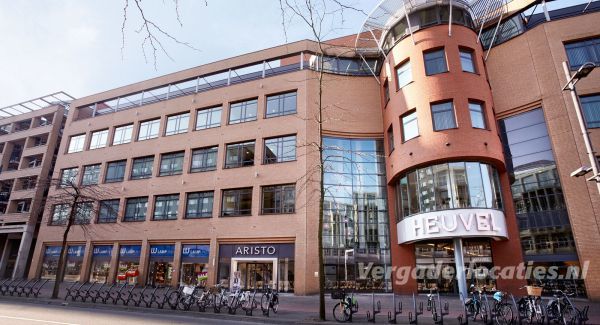3 day course March: Optomechanical system design
At the request of many people, we are organizing the October course again in March.
The course focuses on the mechanical and mechatronic design for optical systems and is intended for mechanical, mechatronic and optical engineers involved in optomechanical system design.
It will also be a very valuable course for any engineer interested in optomechanical design approaches and solutions.
Date: 27, 28, 29 March 2023
Location: Aristo meeting centre, Vestdijk 30, 5611 cc Eindhoven.

Aristo Eindhoven is easily accessible and is located a 5 minute walk away from the NS train station Eindhoven in the city centre.
Investment 2023:
2000 euro for non DSPE members
1800 euro for DSPE and Optence members (excluding VAT)
Including lunch, drinks, snacks, full colour syllabus and dinner on the first courseday.
Program:
Day 1 – Getting from optics to opto-mechanics
• Optical systems and course overview
The course starts with an overview of the field and examples of Opto-Mechatronic systems. An overview of the different topics in the course is given and how they are interconnected. To round of this general start of the course some observations on the general lay-out of optical systems are presented.
• Mechanical sensitivity of optical components
The sensitivity of optical components to mechanical perturbations is treated next since it lays at the foundation of how mechanical and mechatronical requirements are derived from an optical design and optical performance targets. The effect of mechanical perturbations on the performance of an optical system differs greatly for different classes of basic optical components. Plane mirrors for example are insensitive for in-plane translations and rotation and sensitive for out of plane translation and rotations. Spherical lenses on the contrary are sensitive for all translations and first order insensitive for all rotations.
• Exercise on sensitivity
An exercise on sensitivity of optical components based on a real-world case is presented. The exercise is meant to give participants hands-on experience in calculating with optical sensitivities, and showcases some tricks and shortcuts that can be used in many other cases as well.
• Influence of optics on opto-mechanics system engineering
We start the afternoon with how optical principles influence mechanical and opto-mechanical design choices. In optical courses such optical principles are often treated from a theoretical perspective, the goal here is to treat these optical principles from a more practical viewpoint instead, especially focusing on the mechanical consequences.
• Opto-mechanical interface table
We introduce an opto-mechanical interface table that can serve as a tool to organize the mechanical characteristics of the optical components by bringing them together in a structured way. Included in such a table are aspects like size, tolerances, alignment accuracy and stability of all optical components. This is an important tool in the opto-mechanical design process, to structure the relevant information, to support communication in the team, and to minimize the risk of overlooking mechanical requirements.
• Alignment mechanism
In optical systems it is common that tolerances are too tight to assemble the system based on manufacturing tolerances alone. In those cases, the use of alignment mechanisms is crucial to achieve the desired performance. Basic mechanism concepts for standard optomechanical systems are presented. Furthermore a variety of dedicate mechanism designs and commercially available mechanisms is presented. Knowing and understanding the properties of different types of guidance mechanism, alignment screws and locking means are key to both selection of COTS alignment mechanisms as well as design of custom mechanisms.
Evening
• Informal diner in the centre of Eindhoven in a nice Italian restaurant l’Azurro (Dommelstraat 12) where you can take time to get to know your fellow participants and the trainers a bit better.
Day 2 – Tolerancing for optical systems & Optomechanics for Cryo
• Tolerancing for optical systems
Tolerancing is a key factor in achieving the required performance of optical systems, and in doing so at the right price. This requires knowledge of optical manufacturing, understanding what manufacturing limitations stem from these processes, and how the accompanying tolerances should be added to mechanical manufacturing, alignment tolerances and other error sources, through tolerance analysis and error budgeting. Topics treated include all steps of the tolerancing process, sensitivity analyses, practical values for some often-encountered tolerances, use of compensators, use of Monte Carlo simulations, and how to find practical ranges for alignment mechanisms used to correct for many tolerances at once.
• Exercise on sensitivity
After lunch, the exercise on sensitivity of optical components of the previous day will be revisited.
• Opto-Mechanics for Cryogenic Applications
Because of the extreme temperature differences between assembly conditions and operational conditions for optical systems for cryogenic applications, such systems form an excellent showcase for many opto-mechanical concepts. These concepts include athermalization, exact constraint design and low stress mounting. This part of the course therefore contains many examples from practice, such as the MIRI instrument on the James Webb Space Telescope and instruments from ESO’s VLT in Chili. It will be instructive to see a variety of mounting types suited for large temperature differences designed for a myriad of different reflective and transmissive optical component types like mirrors, lenses, prisms, gratings, grisms and filters.
Day 3 – Miscellaneous
• Stability in Opto-Mechanical systems
This part of the course deals with thermal stability and dimensional stability of opto-mechanical systems. It starts with the importance of statically determined design rules, followed by athermal design principles such as the thermal centre and thermal compensation. Design aspects of highly stable base structures such as metrology frames are presented and an example of lumped mass modelling will be treated. The part on dimensional stability deals with effects such as drift due to release of internal material stresses and with drift at interfaces introduced due to applied design principles. A wide variety of characteristics and tables of materials are presented.
• Causes of signal degradation in optical systems
A helicopter overview of many causes of signal degradation in optical systems is given. What is the effect of for example flare, straylight, ghost reflections on optical system performance? And what can be done against it? The various causes and mitigations are not treated in-depth, but instead the aim is to raise awareness and provide a mental checklist to check what seems worthwhile to investigate deeper in a project.
• Preventing Unwanted Light
In optical design there is quite some attention for coatings of optical components. Unfortunately, traditionally there has been much less widespread attention to coatings on mechanical parts. In many optical systems the structural parts require dedicated coatings to avoid unwanted optical effects like stray light. Different wavelengths or angles of incidence ask for different coating types or surface treatments before coating. These various considerations, coating and treatment types are discussed to spread awareness and as a starting point for more in-depth attention when needed in a project.
General schedule
08.45 Coffee & registration
09.00 Lesson
10.45 Break
11.00 Lesson
12.45 Lunch
13.30 Lesson
15.30 Break
15.45 Lesson
17.45 Drinks
18.15 Diner (first day of the course)
Caleidoscopic experience
The teachers are experienced engineers, who know the tricks of the trade in optomechatronics, system architecture, system design and engineering, and optomechanical engineering.

Lennino Cacace
Senior Opto-mechatronic System Architect in Research and Semiconductor Industry at AC Optomechanix. Assistant professor Opto-mechatronics at Eindhoven University of Technology

Pieter Kappelhof
Director Technology Hittech Group, Hybrid Teacher Opto-mechatronics TU Einhoven. Track record as System Designer of optical systems in research and industry .

Gabby Aitink-Kroes
Opto-mechanical systemsdesigner for(space)astronomy.
Senior Design Engineer at the Netherlands Space Institute for Space Research (SRON) .

Jan Nijenhuis
Senior System Engineer at TNO of opto-mechanical systems for space, astronomy andsemiconductor industry.
Please send an email to Annemarie.schrauwen@dspe.nl for further questions.